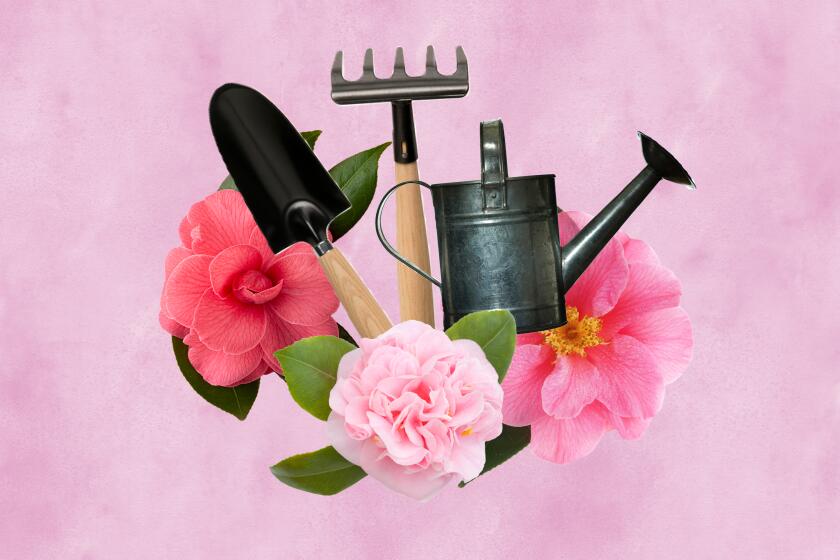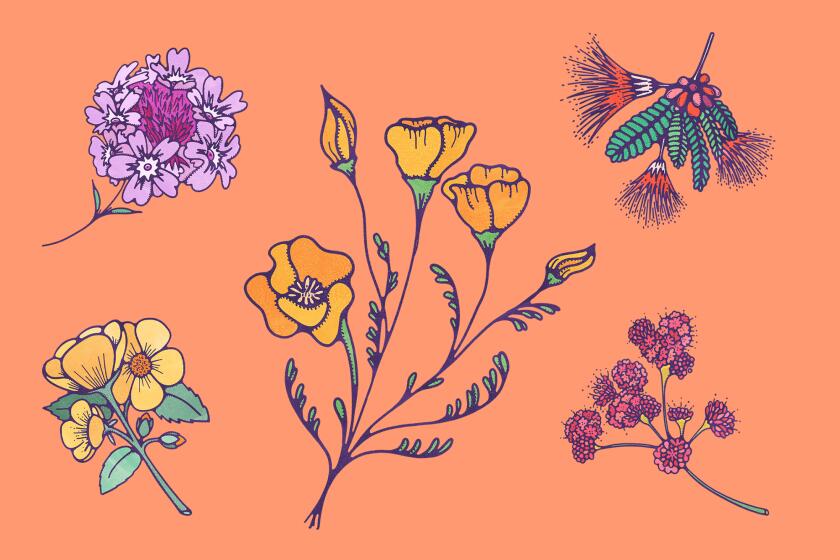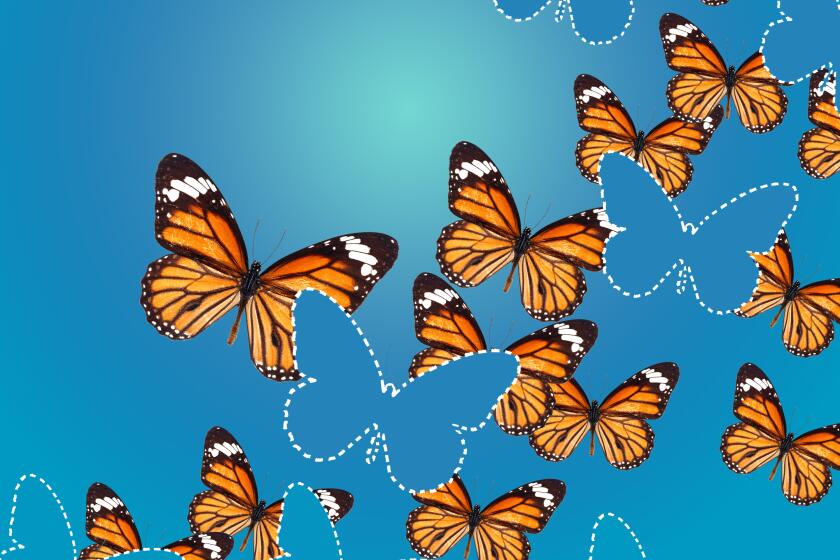He spends his days counting monarch butterflies in L.A. He could use your help
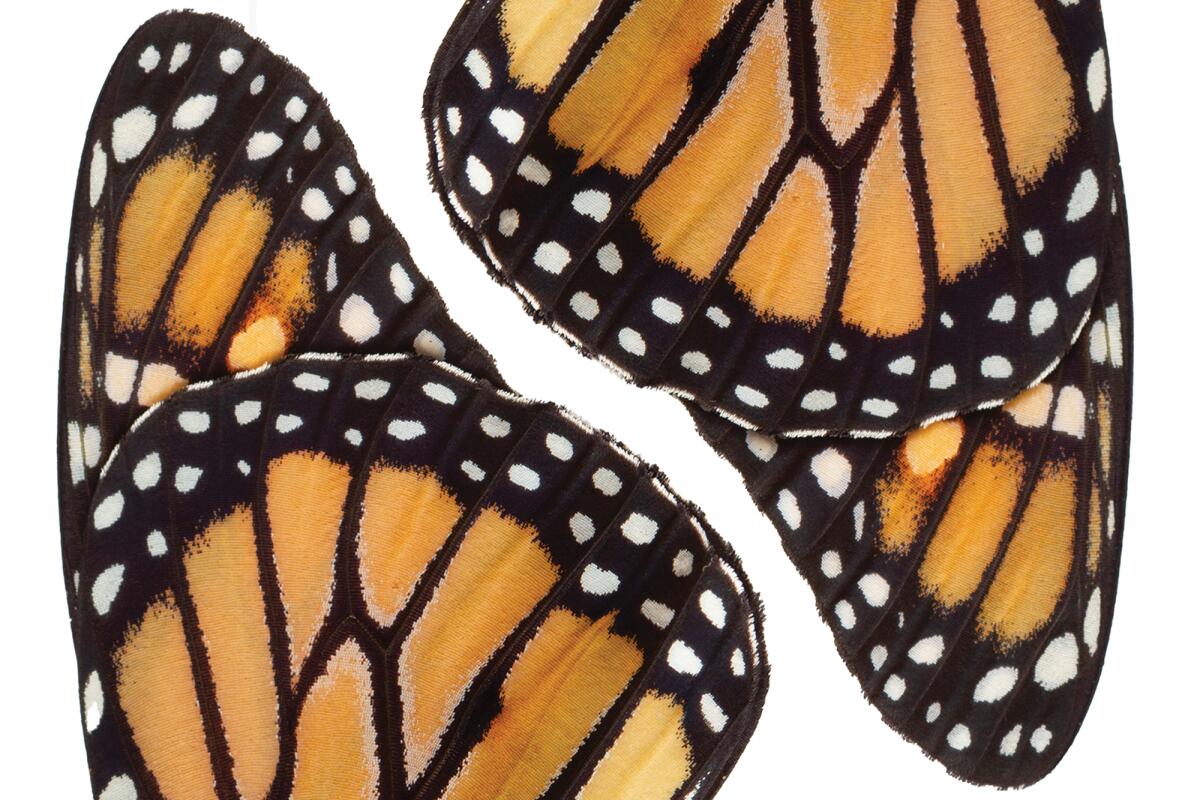
- Share via
It’s 49 degrees in Malibu, practically freezing for Angelenos, and Richard Rachman is peering through a chain-link fence trying to find butterflies.
Rachman is a plant guy — a plant ecologist to be exact — who has trained his scientist eyes to look for tiny details in flowers and trees. But this winter the bearded, burly millennial is spending all his free time counting monarch butterflies in Los Angeles County, dodging poison oak, dog poop and uncooperative property owners to get as accurate a tally as he possibly can of endangered insects not easily found.
For the record:
10:24 a.m. Jan. 16, 2022An earlier version of this story said the increase in the number of monarch butterflies counted this year was 100%. It should have said the increase was 100 times more than the previous year’s count. The story also referred to the count as the Western Monarch Overwintering Count. The correct name is the Western Monarch Thanksgiving Count.
On this early morning in mid-December, Rachman is swathed in a heavy jacket, gloves and scarf, binoculars pressed to his eyes. He’s on the outskirts of a small gated community near Zuma Beach, staring through the fence at a small eucalyptus grove while trying to avoid mounds of dog doo hidden in the brush.

The work is dizzying, requiring you to constantly look down at your feet and then back at the trees, straining to find creatures that feel as mythical as pixies.
“I tell people to look for little Doritos,” he tells his shivering companions. He’s trying to be hopeful, but after 30 minutes of staring at droopy tree limbs in the shady cold, he’s only spotted a couple of monarchs hanging alone on a branch.
Why is it so hard to spot the orange monarch with its distinctive black- and cream-colored markings?
Because the butterflies keep their wings closed when they’re resting, so their coloring isn’t obvious. All you see — when you’re lucky enough to find them — are little mocha-colored triangles hanging from branches like dripping clusters of pale brown leaves.
January is the month to luxuriate in camellias and get your garden in shape for spring by pruning roses, improving garden soil and taking plant and garden classes.
Depending on your angle and the time of day, the monarchs seeking winter shelter in coastal eucalyptus and pine trees are easy to miss. Monarchs can’t fly when temperatures are below 60 degrees, and you can’t reliably count them when they’re flying around, so Rachman, L.A. County’s volunteer coordinator of the Western Monarch Thanksgiving Count, must start early, around sunrise, before the butterflies start moving.
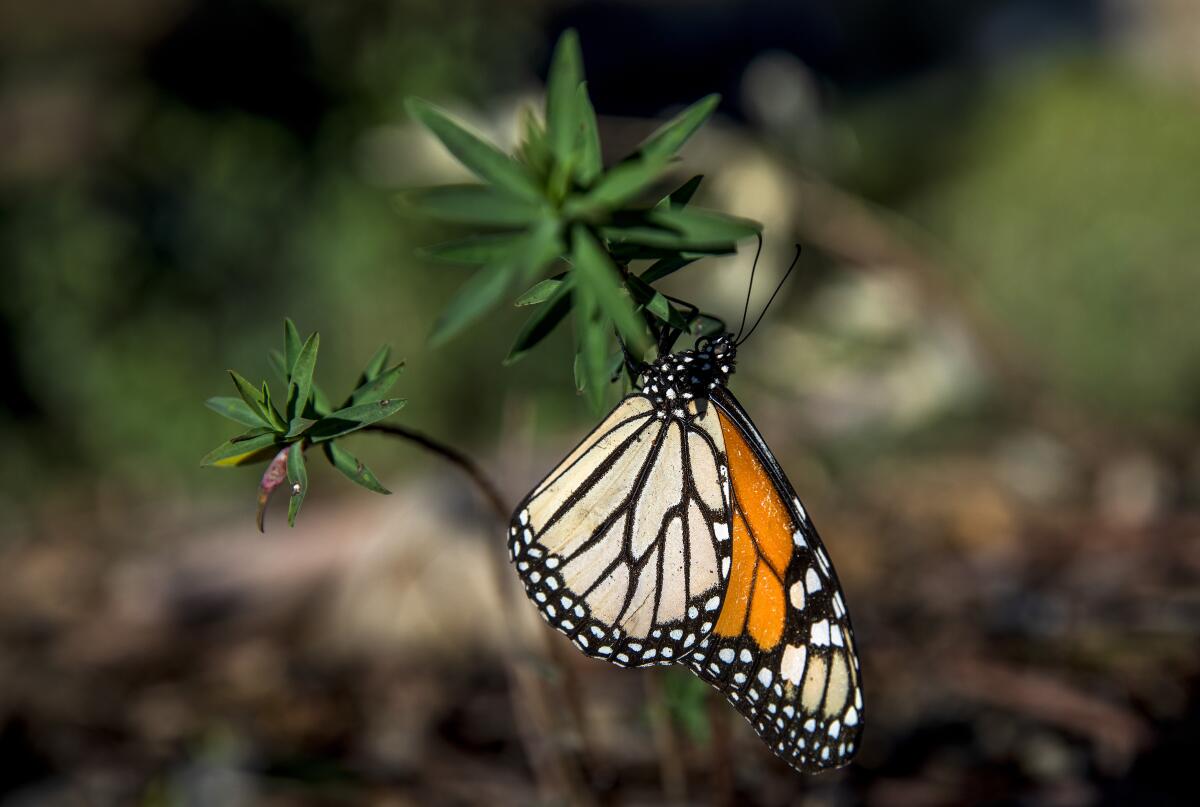
Nearly 800 monarchs were counted at this spot a few days earlier, he said, but that was before the heavy rain and wind in mid-December. A day after the storm, Rachman’s checking to see how the butterflies fared. Things don’t look good until Patt Healy appears and suggests a way to get around the fence to look from another direction. Healy, founder of the Malibu Monarch Project, lives in the area and knows just where to go.
After getting permission to enter the fenced area, the group approaches the grove with the sun at their backs and Rachman’s voice swells with excitement and relief.
From this angle, it’s suddenly easy to see clumps of motionless Doritos shapes hanging from branches.
Ceanothus for Taurus. Lupine for Cancer. Here’s everything you need to know about pairing California native plants with your sun sign.
Rachman readjusts his binoculars and starts calculating — “I look for a group of five, and then use that pattern to count the rest,” he said, and his quick and dirty tally finds at least 725. The butterflies have positioned themselves on the trees so they can catch the first rays of the morning sun, and sure enough, as the temperature warms, their wings begin to flutter, so it’s easier to spot flashes of orange.
This is a reassuring find because during the 2020-21 count, the entire Western monarch tally along the California coast was just 1,914 — a staggering number that signaled a near-collapse of the iconic species.
This year’s count, which began around Thanksgiving 2021 and concluded on Jan. 9, is much improved. The final numbers won’t be released until late this month, but more than 200,000 monarchs have been spotted at overwintering sites along the coast between Central California and northern Baja, 100 times greater than the 2020-21 count, says Emma Pelton, senior endangered species conservation biologist for the Xerces Society for Invertebrate Conservation.
But Pelton isn’t celebrating, because 200,000 is still far from the millions of monarchs that used to migrate from their breeding grounds in Northern California and the Pacific Northwest to the California coast in the 1980s and ‘90s.
If we make mindful decisions about our personal habitat, we can take big steps toward protecting our planet in 2022.
“We’re still at 90% less than where we were at in the 1990s, so this is nothing we can bank on,” Pelton said in a phone interview from her office in Portland, Ore. “We’d like to see at least a half-million or million monarchs before we can say they’re out of the woods (as far as extinction).”
Part of the problem is that scientists don’t know why the monarch numbers plummeted so badly in 2020-21 (down to 1,914 from around 30,000 the two years before) or why they improved this year, Pelton said.
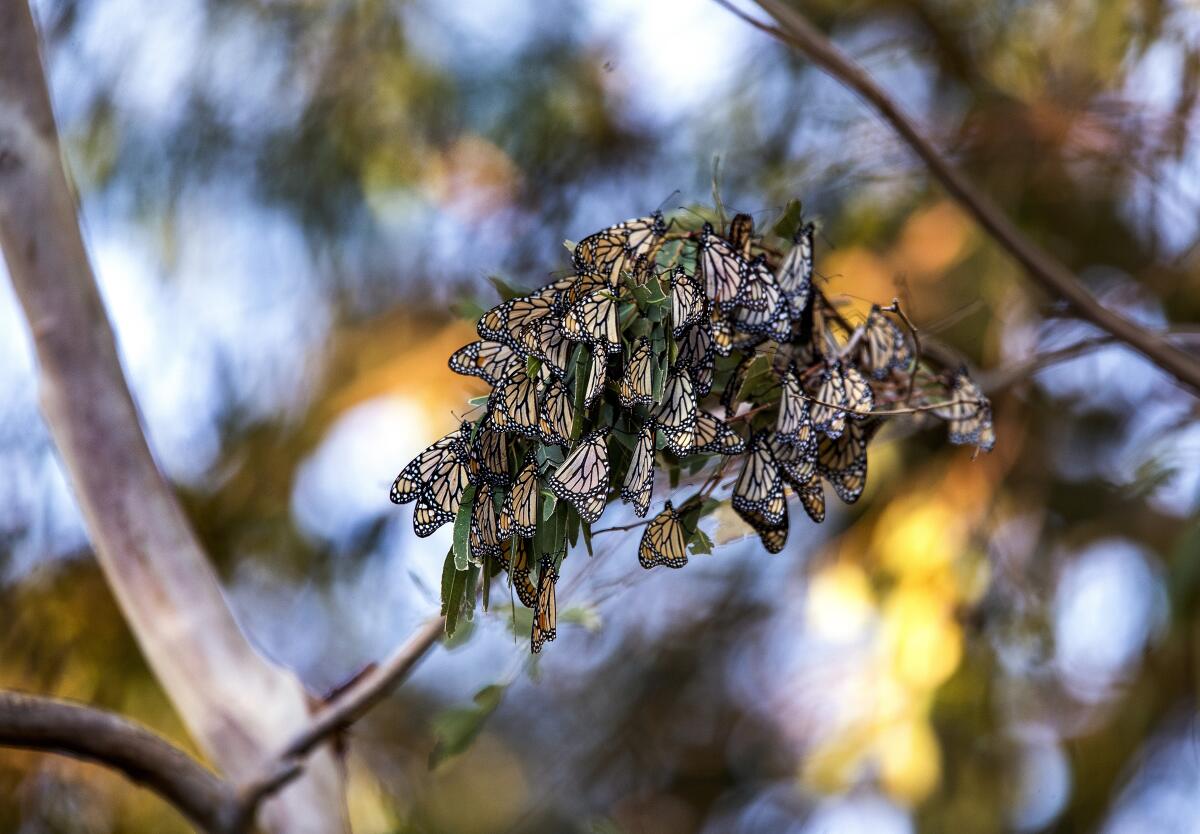
In a November Xerces Society blog post titled “The Bounciness of Butterflies,” Pelton noted that small animal populations are more vulnerable to fluctuations in the environment, such as a bad winter storm, but, by the same token, their numbers can also improve when the conditions are more favorable.
“It is entirely plausible that migratory monarchs had good weather and good luck across their breeding habitat in the West this year and bounced up to a larger size than expected,” Pelton wrote. “While climate change-driven severe drought is associated with declines in butterfly abundance and diversity in the West overall, the effects are complex; warmer and drier summers — like 2021 — can be a temporary boon to some butterfly species.”
Scientists are actively researching a range of theories, she said, everything from the changing patterns of wildfire to changes in crop planting and pesticide use in California’s Central Valley, a possible influx from the Eastern monarch population and winter-breeding monarchs in the San Francisco Bay Area. “However, it’s important to note that these are hypotheses only,” she wrote, “and, as of yet, lack strong evidence to support them.”
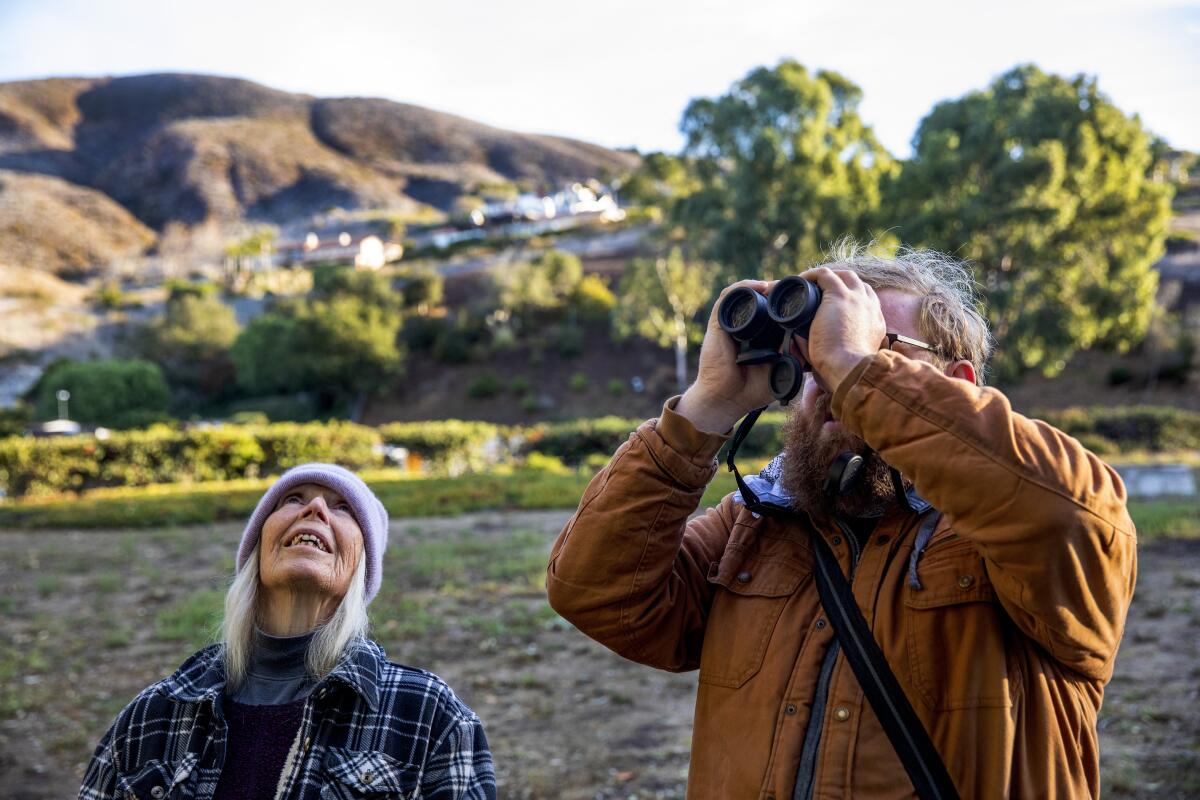
Many people — heeding the call to help the delicate insects — planted milkweed in the last year to help feed the monarchs, and during her phone interview Pelton said those efforts likely helped, but “we didn’t magically plant enough milkweed last year to make this kind of difference.”
Which is not to discount the public’s efforts, she said. “I don’t want to crush anyone’s spirit around trying to help because people’s passion for monarchs ... it’s incredible, it’s huge.”
Ceanothus for Taurus. Lupine for Cancer. Here’s everything you need to know about pairing California native plants with your sun sign.
So why all this concern about a single butterfly species? Pelton laughed a little wearily. “If it wasn’t a bug, people wouldn’t demand a purpose,” or a reason to care, she said.
Monarchs are not awesome pollinators, like native bees, and their numbers have declined so far that few animals rely on them as their primary food source, Pelton said. In fact, most birds avoid them because of the toxins they store in their bodies from eating milkweed, their sole food as caterpillars.
Still, monarchs are an important food for insects like spiders, flies and wasps, who are an important food source for birds, Pelton said. Monarchs are also consumed by mice and other rodents (“we had a very damning photo” of a squirrel in Pacific Grove with a monarch stuffed in its mouth), and even a few birds who have discovered that some monarchs have lower levels of toxic compounds than others. “The smarter species can figure it out by tasting and rejecting some monarchs,” she said.
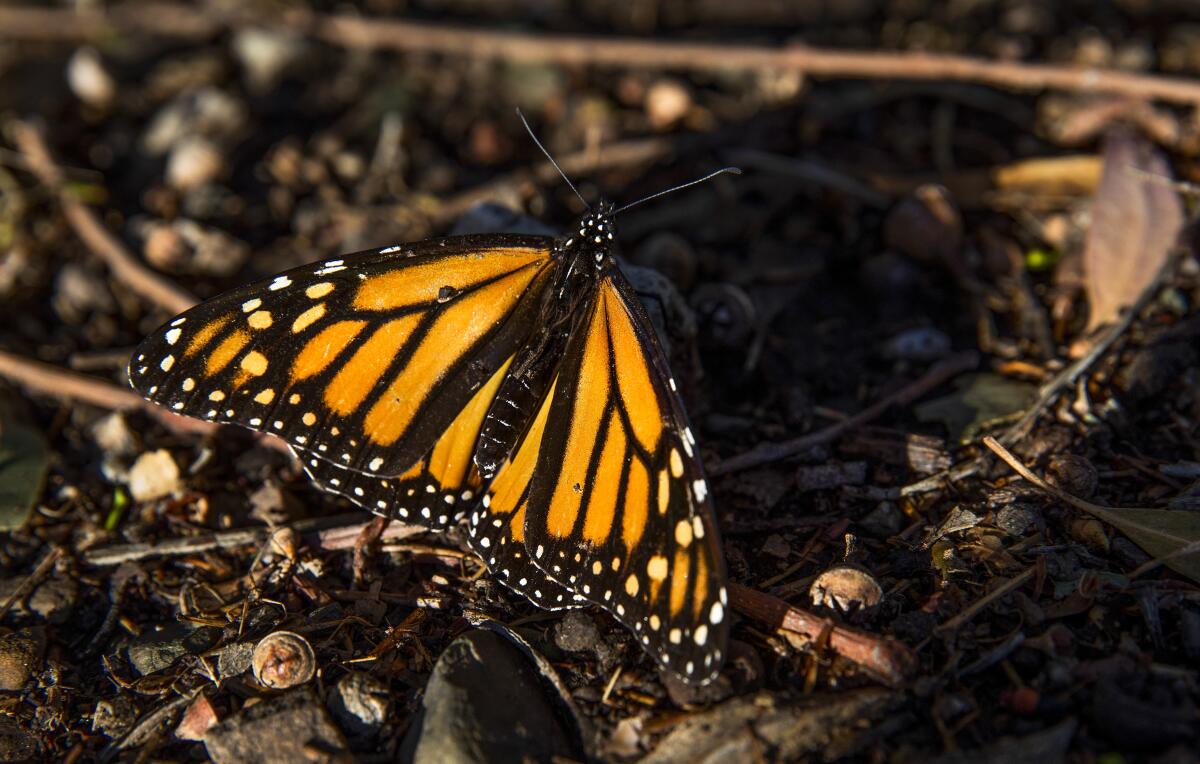
But ultimately, caring about monarchs is a “canary-in-the-coal-mine issue,” Pelton said.
Like miners who take sensitive canaries underground to alert them if the air is going bad, the decline of monarchs is indicative of the demise of all insects, she said. Most birds rely on insects to feed their young, she said, and as our insect population declines, “we are looking at the potential loss of entire bird species.”
There are cultural considerations too, she said, because the monarchs are so iconic, probably the most recognizable of North American butterflies.
And then there’s the still-unsolved mystery of how and why monarchs migrate in the first place. The Western monarchs’ migration is not as far as their Eastern, also dwindling cousins, who fly by the millions from eastern Canada and the United States to overwinter in the southern Mexican state of Michoacán, west of Mexico City.
Those migration patterns are unique to monarchs and evolved over millions of years, she said. “If we lose the monarchs, it would be on our watch and that would be a huge shame,” because scientists would lose the chance to understand that behavior ... and who knows what we could discover once that mystery is unraveled?
Monarch butterflies are turning up earlier than usual at groves in Pacific Grove and Pismo Beach
These questions nag at Rachman too. This is his first year as a monarch butterfly counter, and he takes his duties very seriously. He’s a graduate student at Cal State Northridge, usually tromping through the Santa Monica Mountains looking for native coast live oaks that are dead or dying and scouring them for clues about what may have harmed them, such as tiny bark beetles or sustained drought.
His skill at observation and enthusiasm for science brought him to the attention of the people running the monarch count. When they asked him to be the L.A. County count coordinator, he hesitated. “I said, ‘I can give it a shot, but I don’t really study monarchs, so I don’t know much more than most people.’” And then, scientist that he is, Rachman dove into reading whatever he could about the butterflies and their endangered state.
Last year, Los Angeles County didn’t even have a count coordinator. Fewer than 100 monarchs were found in 25 known overwintering sites around the county, so every cluster his volunteers find this year creates a new surge of excitement. So far, they’ve counted about 4,240 monarchs in the county, and Rachman has been tracking down rumors about other sites where monarchs were spotted in years past.
But the hunt is challenging. Monarchs, when they’re warm enough, leave their branches to search for water and nectar flowers nearby, Rachman said, but they usually return to the same site at night. They usually choose wintering sites on pine or eucalyptus trees that are near fresh water, he said, which is why it’s important to maintain these small coastal groves and the pools of water that feed them. That’s also why monarch researchers encourage people to grow plants with winter blooming nectar flowers to help the adults find food.
Sometimes Rachman learns of past overwintering sites he can’t get into because the land is private and gated, or worse, the trees that once hosted the butterflies have been removed. Other times, it’s just a matter of logistics. The staff at one coastal museum wouldn’t permit him on the property until 9 a.m, “which was way too late,” he said. “And they also wanted me to pay for parking! I said, ‘Are you kidding me? I’m a scientist, I’m not interested in viewing your art.’ That was just scandalous.”
Part of Rachman’s duties include looking for dead monarchs too.
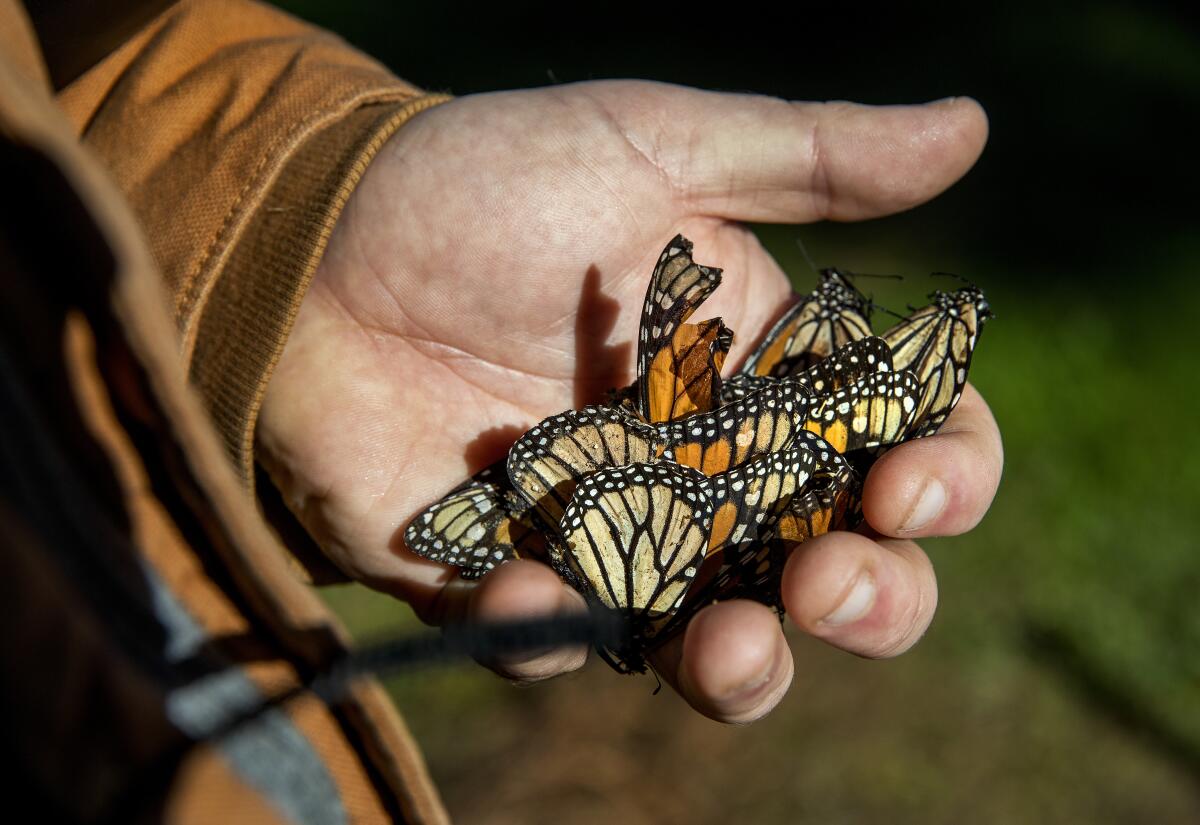
He searches the ground near the counting sites and individually bags any bodies he finds to send to researchers at the Western Monarch Genomics Project, who are studying the genetics of dead monarchs found in three regions of California — the San Francisco area, Monterey Bay and the Los Angeles Basin. It’s not required of counters, but when Rachman learned of the study, he eagerly signed on.
This morning, as his companions gape at the fluttering clusters on the branches, he begins scouring the ground under the trees. He finds several motionless bodies almost entirely camouflaged against the soil and gently pokes one, figuring it’s dead. Instead, the butterfly opens it wings and unsteadily takes flight, landing a few feet away in full sun, flexing its wings as though trying to limber them up.
Suddenly, the group realizes there are dozens of napping butterflies on the ground, so many that everyone starts taking mincing steps away from the trees, fearful of treading on the endangered insects we’ve come all this way to catalog. As they warm up and start moving their wings, Rachman is cheerful. He doesn’t have to collect any butterfly bodies here.
That situation changes at the next stop in Venice, at the Penmar Golf Course. There we find about 250 monarchs clumped together on high pine branches near the entrance. As golfers practice their putts, Rachman spots a trio of Cassin’s kingbirds perched at the top of a tall sycamore tree. It’s almost 8:30 a.m. now, and the monarchs are beginning to fly in the warming air. He watches as the kingbirds suddenly dart from their perch, snatch a butterfly from the sky and return to the treetop to gobble it down.
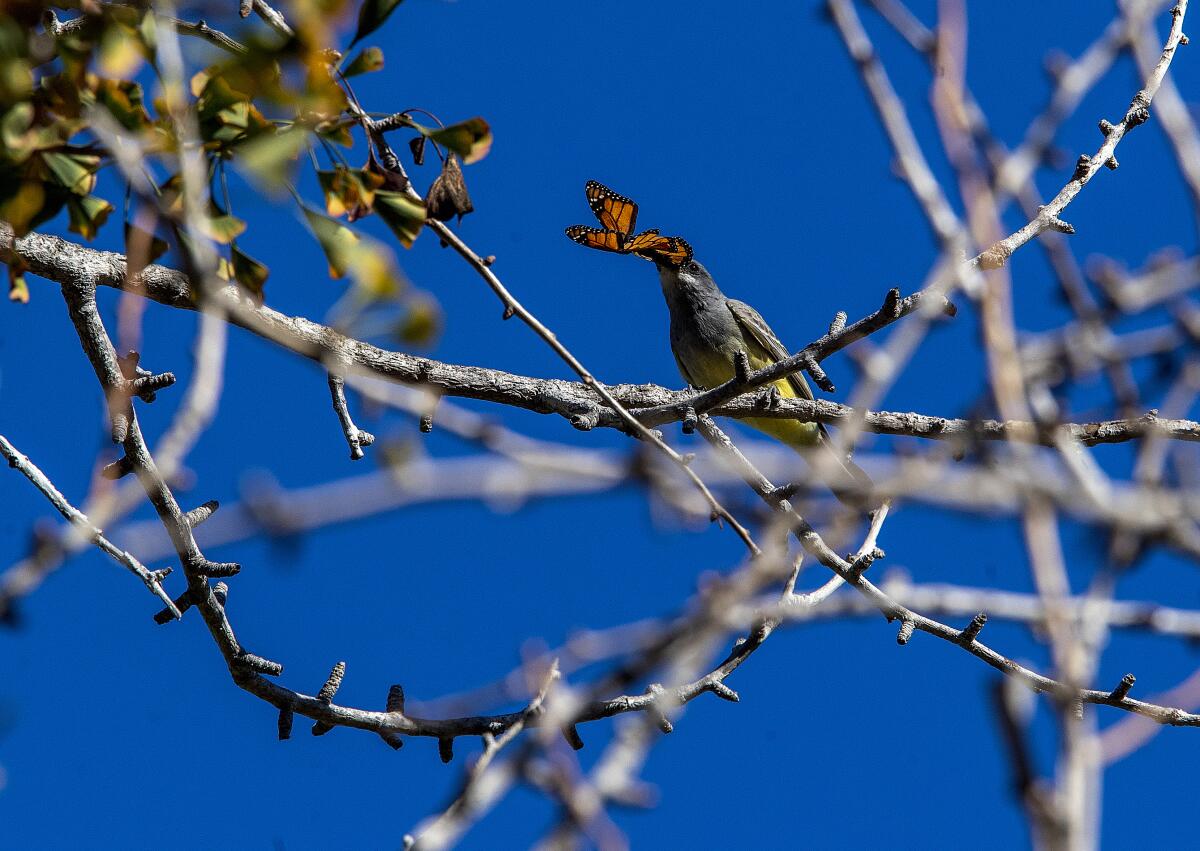
Or try to gobble it down.
Instead, the birds seem to chomp on the butterflies, mashing them in their beaks before letting them fall to the ground. “They must be young,” Rachman said of the birds. “I don’t know why they’re trying to eat them; they’ll only throw up.” But the birds don’t seem deterred. They dart out again and again to grab and maul another monarch. Rachman watches stunned, and then takes off running to the bottom of the tree.
He’s realized suddenly that this observation is a find, one worth recording because kingbirds don’t usually go after monarchs. After all, the milkweed that the monarchs eat when they are still caterpillars makes most birds vomit. He speculates that maybe it’s been so long since monarchs have overwintered here that these young birds have not learned to avoid them. Or maybe the birds are just sampling the insects to see if any are palatable.
Under the tree, Rachman quickly spots seven, no, eight, no nine lifeless monarchs. Several have mangled bodies, others have their wings or heads torn off, as though the birds were trying to find some edible part. This find is so unexpected that Rachman had left his bags in his car, so he cradles their bodies in his hands as he walks gingerly to his car, drawing puzzled stares from golfers near the entrance.
Rachman is sad for the murdered butterflies but exuberant about witnessing something so rare, which he could have easily missed if he hadn’t turned to look.
This is why monarchs are so fascinating, he says, because there’s so much still to learn about their behaviors and predators.
And there’s also just the sheer magic of their existence, even for a scientist like himself.
“To walk into these woodlands, when it’s so chilly you can see your breath, and find trees covered with monarchs ... I say, ‘dripping with monarchs’ ... it just feels awe-inspiring,” he said. “It’s really spectacular.”
That magic and mystery is a large part of why monarchs are so iconic, Pelton said. “But really, all our butterflies and native bees need help.”
Habitat destruction and large-scale pesticide and herbicide are largely to blame for the demise of many insects, including the monarchs, Pelton said, but the general public can help by reducing personal pesticide use and trying to rebuild habitat in personal gardens.
“This is where the public can definitely play a role,” she said, “by supporting all insects and their food webs.”
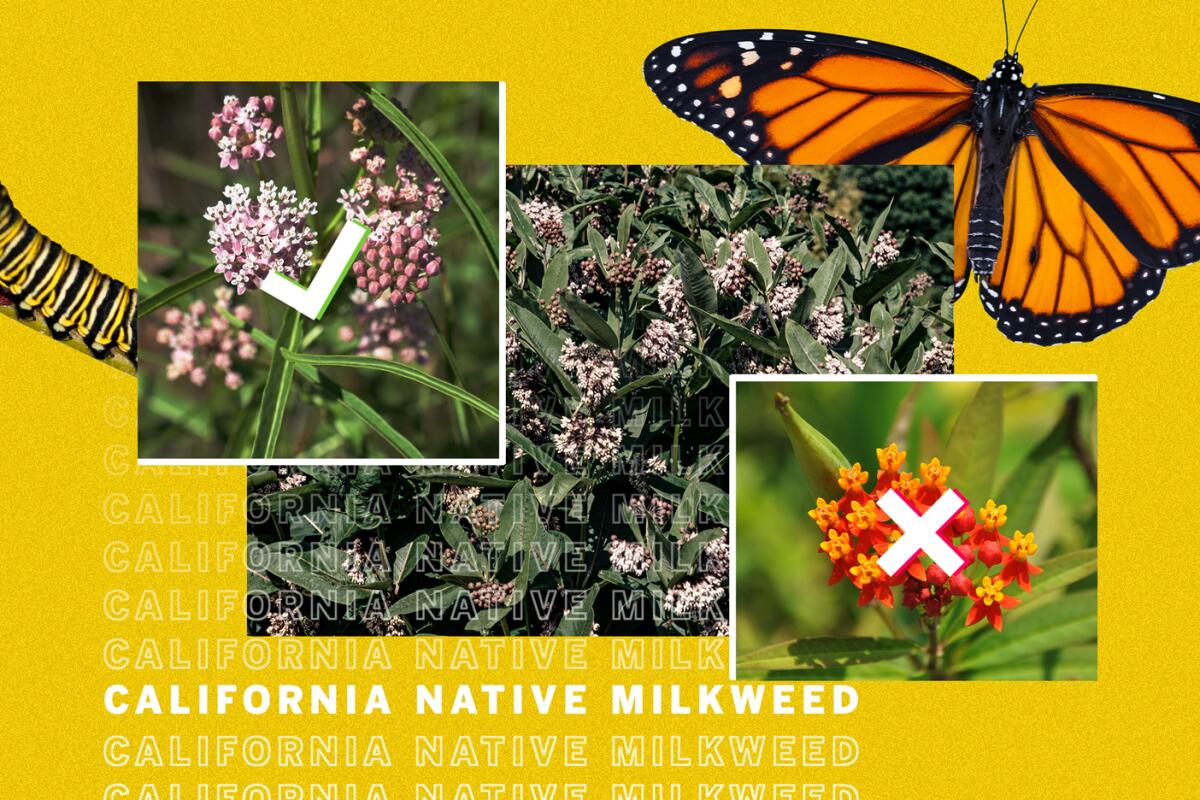
Here’s how you can help monarch butterflies
We can all take small, easy steps to help the iconic insect. Here are a few:
Plant native milkweed
Monarch caterpillars dine exclusively on milkweed, but native milkweed is the only kind to grow, scientists say. Tropical milkweed, the orange-flowered nonnative variety long favored by nurseries and landscapers, is creating problems for the monarch population. The reasons are complicated, but it’s largely because, unlike native varieties, it doesn’t die back in the winter in mild climes. That causes problems on two fronts, experts say. It provides food for monarch caterpillars year-round, which seems to discourage migration and disrupt the breeding cycle. Worse, that same year-round life cycle for the plant allows a protozoan parasite known as OE (Ophryocystis elektroscirrha) to multiply and infect caterpillars as they eat. Scientists suspect that the parasite is weakening the adult monarch population, creating problems in migration and reproduction. If you’re already growing tropical milkweed, the Monarch Joint Venture project recommends cutting it to the ground several times during the winter, to kill the parasites, or remove the plant altogether in favor of native milkweed. The best course of action for gardeners and plant lovers is to consult the California Native Plant Society’s Calscape database to plant milkweed that’s native to your region — such as narrow-leaf milkweed (Asclepias fascicularis) and showy milkweed (Asclepias speciosa) — which grow in most parts of Southern California. Also note that native milkweed is typically dormant this time of year, so you won’t be able to buy plants until late spring or early summer. And finally, scientists warn against planting milkweed if you live within five miles of coastal overwintering sites north of Santa Barbara, or within one mile of the sites south of Santa Barbara. These were never areas where milkweed grew historically, and scientists fear planting milkweed too close to overwintering sites may affect monarch migration and overwintering behavior. (We told you it was complicated.) Still, if you’re serious about helping monarchs, seeking out the appropriate native milkweed is worth the hassle. When the plants start hitting shelves this spring, we suggest shopping at nurseries that know their native plants (see below). And you don’t need a big, fancy garden — even a pot of native milkweed on a front porch, or a patio, can make a difference.
Use plants without pesticides
This is trickier than it sounds, because aphids love to congregate on milkweed, and buyers are usually turned off by buggy plants at a nursery. Some nonorganic wholesalers use systemic pesticides to keep aphids and other unattractive bugs off their young plants, but the caterpillars who eat those plants also get sick and/or die, Pelton said. Your options are to try to grow native milkweed from seed — see instructions at monarchwatch.org — or make sure the nursery you buy from is selling plants that are pesticide-free. Native plant nurseries tend to grow organically, but it’s always a good idea to ask before you buy. For a deeper dive into growing milkweed, read the Xerces Society’s online “Milkweeds—A Conservation Practitioner’s Guide.”
Browse native plant nurseries
Many retail nurseries have a native plant section, but if you’re serious about creating habitat in your garden space, it’s instructive to visit nurseries devoted to native plants, such as the Theodore Payne Foundation in Sun Valley, Tree of Life Nursery in San Juan Capistrano, Hahamongna Native Plant Nursery in Pasadena, California Botanic Garden’s Grow Native Nursery in Claremont and Artemisia Nursery in the El Sereno area of northeast Los Angeles. Moosa Creek Nursery in Valley Center sells native plants online, which home gardeners can pick up at participating nurseries.
Plant nectar-producing flowers
Monarch caterpillars only eat milkweed, but once they sprout their wings, adult monarchs feed on all kinds of nectar-producing flowers, said Pelton. “They’re not picky as adults, but native plants tend to be good because they benefit other animals as well.” The Xerces Society has a list of native plants that are attractive to monarchs. Try planting different types of flowers, so you have blooms throughout the year. Experts especially recommend growing winter-blooming nectar flowers in coastal areas where adult monarchs may be overwintering, such as California lilacs (Ceanothus), manzanita, blue dicks (Dichelostemma capitatum) and seaside daisies (Erigeron glaucus).
Get involved
The Monarch Joint Venture website — monarchjointventure.org — has a list of ways you can help monarchs beyond planting milkweed. For instance, you can lobby elected local, state and federal officials about preserving overwintering sites, volunteer to be a counter during next winter’s monarch count or collect data as a community scientist. Another valuable resource: the Xerces Society’s Western Monarch Call to Action.
But don’t raise monarchs
Many people have started raising monarchs to try to preserve the species, but scientists believe the practice is doing more harm than good, said Pelton, because the reared butterflies are often heavily diseased and staying in the same community year-round, rather than migrating. This is a tricky problem, because the people raising monarchs fiercely believe they are protecting the butterflies. Their intentions are good, she said, “but there’s a difference between thinking you’re helping and actually helping.” For starters, raising monarchs is illegal in California unless you have a special scientific collection permit from the California Department of Fish and Wildlife. “People are super passionate about rearing monarchs, but a couple of studies have looked at the disease rates [of home-reared monarchs], and they’re sky-high, with 75% heavily infected with the OE parasite,” Pelton said. “Since the population has crashed, we’ve learned more about the disease transfer [from monarchs raised in captivity to wild monarchs] and how fragile the migration pattern is. Florida has a population of highly diseased monarchs living on tropical milkweed, and they don’t migrate, so it’s a dangerous game. It’s better to help by planting milkweed and nectar flowers and stopping pesticide use.”
—Jeanette Marantos
More to Read
Sign up for The Wild
We’ll help you find the best places to hike, bike and run, as well as the perfect silent spots for meditation and yoga.
You may occasionally receive promotional content from the Los Angeles Times.
